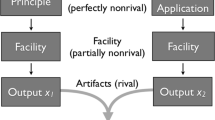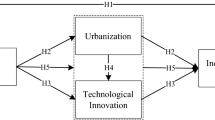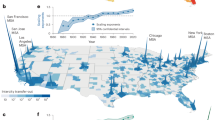Abstract
Both traditional and modern uses of the term infrastructure are related to “synergies”, what economists call positive externalities, that are incompletely appropriated by the suppliers of goods and services within an economic system. The traditional idea of infrastructure was derived from the observation that the private gains from the construction and extension of transportation and communication networks, while very large, were also accompanied by additional large social gains. Thus, society as a whole had an interest in promoting these networks because they created new opportunities for economic choice and growth through spillovers that were involuntary in the sense that they could neither be avoided nor entirely captured by the creators of transportation and communication networks.1 Over the past century, publicly regulated and promoted investments in these types of infrastructure have been so large, and the resulting spread of competing transportation and communications modalities have become so pervasive, that they have come to be taken as a defining characteristic of industrialized nations. The size and pervasiveness of these traditional infrastructures is now so great that they no longer command the social attention and priority that previously supported their public subsidization and regulation.
Access this chapter
Tax calculation will be finalised at checkout
Purchases are for personal use only
Preview
Unable to display preview. Download preview PDF.
Similar content being viewed by others
References
Abramovitz, M. 1989. Thinking About Growth and Other Essays on Economic Growth and Welfare. Cambridge: Cambridge University Press.
Aiken, H. 1956. The future of automatic computing machines. In Elektronische Rechenmaschinen und Informationsverarbeitung, proceedings of a symposium published in Nachrichtentechnische Fachberichte (4): 32–34. Braunschweig: Vieweg.
Barabaschi, S. 1992. Managing the growth of technical information. In Technology and the Wealth of Nations, edited by N. Rosenberg, R. Landau, and D.C. Mowery. Stanford: Stanford University Press.
Blakeslee, T.R. 1975. Digital Design with Standard MSI and LSI. New York: John Wiley and Sons.
Brand, S. 1983. The Media Lab: Inventing the Future at MIT. New York: Viking
Braun, E. and S. Macdonald. 1982. Revolution in Miniature: The History and Impact of Semiconductor Electronics. Cambridge: Cambridge University Press.
Bush, V. 1945. Science: The Endless Frontier. United States Office of Research and Development. Washington, D.C.: U.S. National Science Foundation (reprint 1960 ).
Ceruzzi, P. 1986. An unforseen revolution: Computers and expectations, 19351985. In Imagining Tomorrow, edited by Joseph Corn. Cambridge: MIT Press.
Cohen, W.M. and D.A. Levinthal. 1990. Absorptive capacity: A new perspective on learning and innovation. Administrative Sciences Quarterly 35: 128–152.
Cohen, S. and J. Zysman. 1987. Manufacturing Matters. New York: Basic Books.
David, P.A. 1975. Technical Choice, Innovation and Economic Growth. Cambridge: Cambridge University Press.
David, P.A. and D. Foray. 1994. Accessing and expanding the science and technology knowledge-base: A conceptual framework for comparing national profiles in systems of learning and innovation. Working Group on Innovation and Technology Policy, DSTIJSTPII’IP (94) 4, Paris: OECD.
David, P.A. and W.E. Steinmueller. 1994. Economics of compatibility standards and competition in telecommunications networks. Information Economics and Policy 6: 217–241.
Flamm, K. 1987. Targeting the Computer: Government Support and International Competition. Washington, D.C.: The Brookings Institution.
Flamm, K. 1988. Creating the Computer: Government, Industry, and High Technology. Washington, D.C.: The Brookings Institution.
Kuznets, S. 1966. Modern Economic Growth. New Haven: Yale University Press.
McGraw, T.K. 1984. Prophets of Regulation. Cambridge: Belknap Press of Harvard University Press.
van Meijl, H. 1994. The influence of spillovers, product differentiation, and entry on technological change. MERIT Research Memorandum, 94–026. Maastricht, The Netherlands.
Mowery, D.C. and W.E. Steinmueller. 1994. Prospects for entry by developing countries into the global integrated circuit industry: Lessons from the United States, Japan, and the NIEs, 1955–1990. In Science and Technology Policy in Interdependent Economies, edited by D.C. Mowery. Boston: Kluwer Academic Publishers.
Nelson, R.R. and S. Winter. 1982. An Evolutionary Theory of Economic Change. Cambridge: Harvard University Press.
Okimoto, D.I., T. Sugano, and F.B. Weinstein, eds. 1984. Competitive Edge: The Semiconductor Industry in the U.S. and Japan. Stanford: Stanford University Press.
Prahalad, C.K. and G. Hamel. 1990. The core competence of the corporation. Harvard Business Review 90 (May-June): 79–91.
Pugh, E.W, L.R. Johnson, and J.H. Palmer. 1991. IBM’s 360 and Early 370 Systems. Cambridge: MIT Press.
Ritchie, D. 1986. The Computer Pioneers. New York: Simon and Schuster.
Rosenberg, N. 1976. Perspectives on Technology. Cambridge: Cambridge University Press.
Rosenberg, N. 1990. Why do firms do basic research (with their own money)? Research Policy 19 (2): 165–174.
Steinmueller, W.E. 1988. Industry structure and government policies in the U.S. and Japanese integrated-circuit industries. In Government Policy Towards Industry in the United States and Japan, edited by John B. Shoven. Cambridge: Cambridge University Press.
Tassey, G. 1992. Technology Infrastructure and Competitive Position. Norwell, Massachusetts: Kluwer Academic Publishing.
Teece, D.J. 1987. Profiting from technological innovation: Implications for integration, collaboration, licensing and public policy. In The Competitive Challenge: Strategies for Industrial Innovation and Renewal, edited by D. J. Teece. Cambridge: Ballinger.
Williams, M.R. 1985. A History of Computing Technology. Englewood Cliffs, New Jersey: Prentice-Hall, Inc.
Winter, S.G. 1987. Knowledge and competence as strategic assets. In The Competitive Challenge: Strategies for Industrial Innovation and Renewal, edited by D.J. Teece. Cambridge: Ballinger.
Editor information
Editors and Affiliations
Rights and permissions
Copyright information
© 1996 Springer Science+Business Media Dordrecht
About this chapter
Cite this chapter
Steinmueller, W.E. (1996). Technological Infrastructure in Information Technology Industries. In: Teubal, M., Foray, D., Justman, M., Zuscovitch, E. (eds) Technological Infrastructure Policy. Economics of Science, Technology and Innovation, vol 7. Springer, Dordrecht. https://doi.org/10.1007/978-94-015-8739-6_5
Download citation
DOI: https://doi.org/10.1007/978-94-015-8739-6_5
Publisher Name: Springer, Dordrecht
Print ISBN: 978-90-481-4649-9
Online ISBN: 978-94-015-8739-6
eBook Packages: Springer Book Archive




